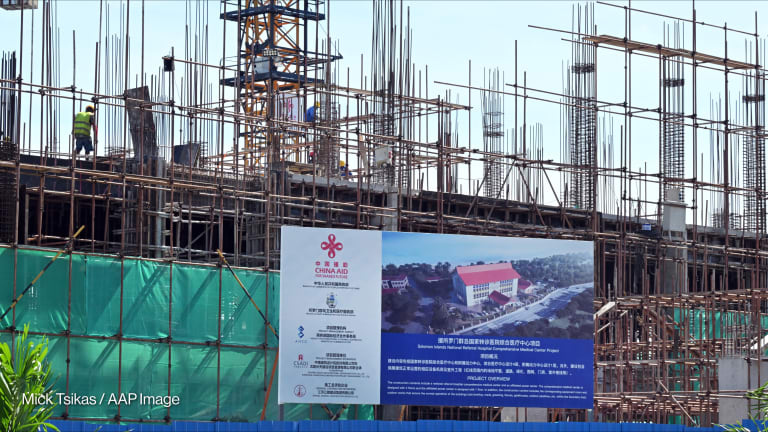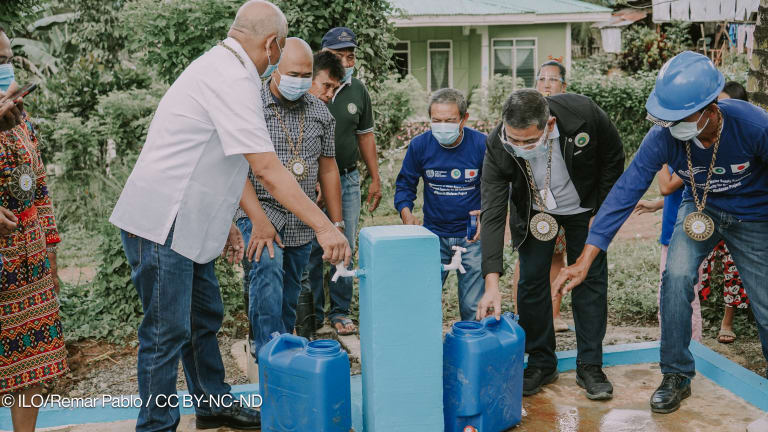Data insights into DFAT's changing funding priorities
This November will be the seventh anniversary of the merger between AusAID and DFAT, but it is only now that the data is showing the impact of this shift. Devex has analyzed this data to bring you the key insights.
CANBERRA — This November will be the seventh anniversary of the merger between AusAID and the Department of Foreign Affairs and Trade, which aimed to enable greater integration of Australia’s aid program with wider foreign policy — including trade programs. The merger occurred following the election of a Liberal coalition government headed by then-Prime Minister Tony Abbott. Headed by Julie Bishop, the foreign minister at the time, the new aid program focused on smarter spending and included a greater emphasis on innovation and engagement with the private sector. In 2017, a foreign policy white paper was released, seeking to reduce the geographic footprint of Australia’s aid program while concentrating on what it defined as the Indo-Pacific region. Since Abbott, Australia has had two other prime ministers, a new foreign minister, and a range of ministers and assistant ministers for international development and the Pacific who have aimed to shape new directions for the aid program — with budget cuts and calls for Australian aid to benefit Australians at home as the main components. Despite the political turmoil, it is only now that the data is showing the impact of the merger and the political shifts — and Devex has analyzed this data to assess the changing Australian aid priorities. DFAT’s publicly available data As a participant in the International Aid Transparency Initiative, DFAT makes available data on development assistance disbursements and commitments that date back to 2008. The data covers both Australian aid programs, as well as activities of other Australian government departments, including the Australian Border Force, that are classified as official development assistance. In total, the data provides insights into 13,139 funding commitments valued at 46.6 billion Australian dollars ($32.6 billion) and 13,750 disbursements valued at AU$39.5 billion announced since 2008. Missing in the data is key information on whom aid funding is distributed to and through whom. Which organizations the Australian aid program partners with is not clearly defined and can only be assessed through titles and program descriptions that may or may not detail delivery partners. This is an important element in understanding how much of the aid program has been outsourced since the merger that cannot be assessed. But the data does provide valuable insights into country and sector commitments at a level of detail that can show how the merger has changed the aid program, which we can see by comparing data from 2013 with data for 2019. A contracting geography In 2013, Australia’s development assistance targeted 138 countries and regions and 120 distinct sectors through 988 commitments, valued at AU$3.3 billion. Australia’s aid footprint was global, with programs in Africa, Asia, South and Central America, the Middle East, and the Pacific. But the Pacific and Southeast Asia were priority areas. Papua New Guinea saw the largest focus for the Australian aid program, with commitments of AU$618.4 million made in 2013. This was followed by the Solomon Islands with AU$345.6 million and Indonesia with AU$315.3 million, while Cambodia, Pakistan and Bangladesh also appeared among the ten priority countries and regions. In 2019, PNG still appeared in the top ten countries and regions by commitments — but only just. Across time, new commitments from Australia’s development assistance have declined to AU$18.3 million, despite disbursement from commitments made in 2013 and 2014 still seeing the distribution of funds rise. The sectors receiving new commitments in PNG have seen a dramatic shift under the changing political focus. In 2013, transport, effective governance, health, education, and justice and law were the priority of aid investments. But gender equality, business support, human rights, and trade were also a focus as AusAID — and other agencies contributing to ODA — targeted 35 distinct sectors. In 2019, new Australian aid commitments targeted just five sectors in PNG, covering policing, education, and "personnel services” supporting the Pacific Connect program. By this time, Australia’s overall aid footprint through new commitments had shrunk to concentrate on the Indo-Pacific and Southeast Asia regions, with some projects still occurring in the Middle East and Africa as part of humanitarian assistance or security initiatives in line with the directives of the foreign policy white paper. Changing sectoral focus The sectoral shift seen in PNG is not specific just to this country. Throughout Australia’s aid program, there has been a wider sectoral shift and a dramatic reduction in funds for what used to be the priority areas. In 2013, 120 distinct sectors received commitments for financial support through Australia’s development assistance, with transport as the priority. This sector, which includes programs supporting road, rail, and aid programs, as well as transport policy, received more than AU$550 million in commitments for the year and included AU$390 million in the second phase of the PNG-Australia Transport Sector Support Program. Education was the second-largest priority, receiving AU$488.9 million in commitments, followed by justice and law programs with AU$265.6 million, agriculture with AU$237.8 million, and health with AU$222.7 million. By 2019, the sectoral focus had narrowed to 54 distinct areas for the aid program. Transport was still among the top sectors in second place, receiving AU$150 million in new commitments. But multisectoral aid was the biggest priority, receiving AU$165.2 million, with funds delivered under the Australian NGO Cooperation Program or program administration activities placed in this category. General personnel services, primarily involving people-to-people knowledge-sharing programs, increased in priority, with education and disaster relief also increasing in importance under the changing aid program. Of the top five sectors in 2019, only the general personnel services sector has received a commitment increase since 2013. What lessons can the UK learn? Analyzing Australian aid data shows that the merger of the Department for International Development and the Foreign & Commonwealth Office in the U.K. — and the political, policy, and personnel changes made — will not be reflected in publicly available data for years to come. The merger will result in new reviews that will lead to policy directives and then flow on to the delivery of development assistance — a process that may take six years before seeing any impact. Even today, the shifting policies created years ago are impacting DFAT staff with an announcement Wednesday that 60 jobs will be cut due to a reduced aid footprint and the effects of COVID-19. For access to in-depth analysis, insights, and funding opportunities from over 850+ sources — combined with Devex Pro news content — sign up to a Pro Funding subscription online today or get in touch to learn about our Pro Funding group options.
CANBERRA — This November will be the seventh anniversary of the merger between AusAID and the Department of Foreign Affairs and Trade, which aimed to enable greater integration of Australia’s aid program with wider foreign policy — including trade programs.
The merger occurred following the election of a Liberal coalition government headed by then-Prime Minister Tony Abbott. Headed by Julie Bishop, the foreign minister at the time, the new aid program focused on smarter spending and included a greater emphasis on innovation and engagement with the private sector. In 2017, a foreign policy white paper was released, seeking to reduce the geographic footprint of Australia’s aid program while concentrating on what it defined as the Indo-Pacific region.
Since Abbott, Australia has had two other prime ministers, a new foreign minister, and a range of ministers and assistant ministers for international development and the Pacific who have aimed to shape new directions for the aid program — with budget cuts and calls for Australian aid to benefit Australians at home as the main components.
This story is forDevex Promembers
Unlock this story now with a 15-day free trial of Devex Pro.
With a Devex Pro subscription you'll get access to deeper analysis and exclusive insights from our reporters and analysts.
Start my free trialRequest a group subscription Printing articles to share with others is a breach of our terms and conditions and copyright policy. Please use the sharing options on the left side of the article. Devex Pro members may share up to 10 articles per month using the Pro share tool ( ).
Lisa Cornish is a former Devex Senior Reporter based in Canberra, where she focuses on the Australian aid community. Lisa has worked with News Corp Australia as a data journalist and has been published throughout Australia in the Daily Telegraph in Melbourne, Herald Sun in Melbourne, Courier-Mail in Brisbane, and online through news.com.au. Lisa additionally consults with Australian government providing data analytics, reporting and visualization services.








